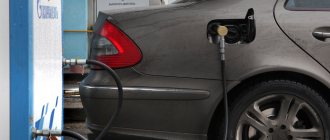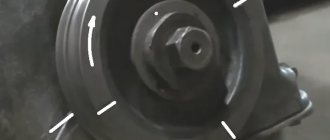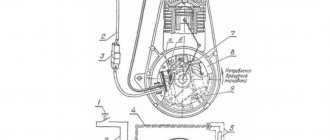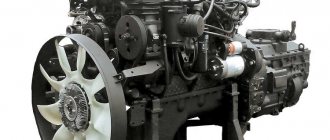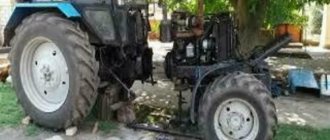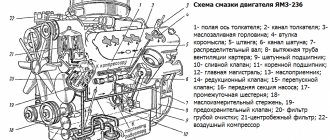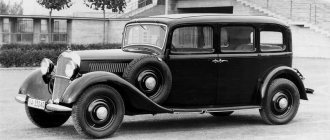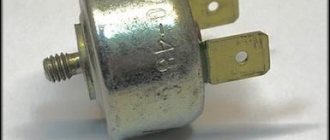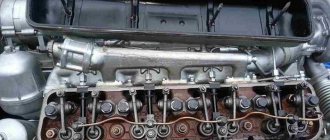During the intake stage, the piston moves down, the intake valve opens, and a combustible mixture enters the cylinder cavity, which, when mixed with the remainder of the spent mixture, forms a working mixture.
When choosing power equipment, special attention must be paid to the type of engine. There are two types of internal combustion engines: 2-stroke and 4-stroke.
The principle of operation of an internal combustion engine is based on the use of such a property of gases as expansion when heated, which is carried out due to the forced ignition of a combustible mixture injected into the air space of the cylinder.
You can often hear that a 4-stroke engine is better, but to understand why, you need to take a closer look at how each works.
The main parts of an internal combustion engine, regardless of its type, are the crank and gas distribution mechanisms, as well as systems responsible for cooling, power supply, ignition and lubrication of parts.
The useful work of the expanding gas is transferred through a crank mechanism, and the gas distribution mechanism is responsible for the timely injection of the fuel mixture into the cylinder.
Four-stroke engines - Honda's choice
Unlike a two-stroke engine, in which the crankshaft, crankshaft bearings, compression rings, piston, piston pin and cylinder are lubricated by adding oil to the fuel; The crankshaft of a four-stroke engine is in an oil bath. Thanks to this, there is no need to mix gasoline with oil or add oil to a special tank. It is enough to pour clean gasoline into the fuel tank and you are ready to go, eliminating the need to purchase special oil for 2-stroke engines.
Carburetor engine duty cycle:
— Compression stroke The piston goes from BDC to TDC, compressing the working mixture. In this case, the temperature of the mixture increases significantly. The ratio of the working volume of the cylinder at BDC to the volume of the combustion chamber at TDC is called the compression ratio. The compression ratio is a very important parameter; usually, the higher it is, the greater the fuel efficiency of the engine. However, an engine with a higher compression ratio requires higher octane fuel, which is more expensive. Expansion stroke, or power stroke
The GIF clearly demonstrates the operation of a four-stroke engine.
— Exhaust stroke After BDC of the working cycle, the exhaust valve opens and the upward moving piston displaces the exhaust gases from the engine cylinder. When the piston reaches TDC, the exhaust valve closes and the cycle begins again.
It is almost impossible to completely clean the engine cylinders from combustion products (too little time), therefore, with the subsequent intake of a fresh combustible mixture, it moves with the residual exhaust gases and is called the working mixture.
The residual gas coefficient characterizes the degree of contamination of the fresh charge with exhaust gases and is the ratio of the mass of combustion products remaining in the cylinder to the mass of the fresh combustible mixture. For carburetor engines, the residual gas coefficient is in the range of 0.06-0.12.
In relation to the power stroke, the intake, compression and exhaust strokes are auxiliary.
Operating cycle of a diesel engine The operating cycles of a four-stroke diesel engine and a carburetor engine differ significantly in the method of mixture formation and ignition of the working mixture. The main difference is that during the intake stroke, not a combustible mixture enters the diesel cylinder, but air, which, due to the high degree of compression, is heated to a high temperature, and then finely atomized fuel is injected into it, which spontaneously ignites under the influence of high air temperature.
How does a simple engine work?
CLAIM
What is the displacement of a car engine? One of the most important characteristics of any gasoline or diesel engine is its displacement.
Since the advent of the first internal combustion engines, this characteristic of the engine has been a primary indicator, according to 1. Internal combustion engine: a 5-stroke rotary engine with rotating shut-off elements, separate compression and expansion sections of the working fluid and separate combustion chambers of constant volume, containing a cylindrical rotor capable of rotating, equipped with blades, which is placed in a hollow body equipped with windows for gas exchange, having symmetrically placed cylindrical hollow sockets around the circumference of the inner surface of the body, the number equal to the number of rotor blades, where locking drums that can rotate are installed, in which the volumetric relationship of the outer cylindrical surface of the rotor and the annular the inner surface of the housing, as well as the surfaces of the rotor blades and locking drums, forms working chambers - “expansion” segments and “release” segments, which can change their volume, and have a drive from the main shaft through gear transmissions to the shafts of other rotating technological elements, different the fact that in the engine body there are separate compression sections with bladed rotors placed in them that can rotate, and the number of these compression sections is equal to the number of blades of the main working rotor and the number of locking drums; as well as on the engine body, hollow combustion chambers of constant volume are arranged, with a number twice the number of locking drums, while the volumes of the compression sections, combustion chambers and the volumes of the arc sectors of the main rotor section of the engine are mutually located so that they can communicate with each other through extremely short gas ducts with bypass windows that can be periodically unlocked and locked due to the action of cylindrical spool valves that can rotate, in a mode that ensures the sequential implementation of the full cycle of technological strokes of the internal combustion engine; at the same time, the mutual placement of the working agent bypass windows, the mode of their “unlocking-locking” by cylindrical spool valves that can rotate, as well as the interconnected correspondence of the angular positions of the main working rotor blades that can rotate, the rotor blades of the compression sections and the openings of the locking drums, as well as the adjustment of the moments sparks of the spark plugs are arranged so that the ignition and complete combustion of the compressed working mixture in the combustion chambers can occur in a locked and constant volume of these chambers with all the working fluid bypass windows closed, and the operating mode of each group of two combustion chambers for each expansion sector of the main rotor section is configured so that from two adjacent chambers that have the ability to eject working gases into the same expansion segment of the main rotor section, each successive “expansion” stroke only one of them has the ability to eject gases into the expansion sector, and such a sequential alternation mode connection between the combustion chambers in strokes of connection with the expansion segment of the main rotor section can be carried out in a translational sequence.
2. The engine according to claim 1, characterized in that the main working rotor and each of the rotors of the compression sections have common locking drums; in this case, the rotors and locking drums, tightly in contact with each other with cylindrical side surfaces, are able to rotate in accordance with such angular velocities that their cylindrical surfaces rotate in opposite directions with the same linear speed, that is, they contact the surfaces in the rolling mode without slipping and friction relative to each other each other, while the diameter of the locking drums has a size relative to the diameter of the cylindrical surface of the main rotor - as many times smaller as the number of passage openings in the drum is less than the number of blades on the main rotor (for example: 2 or 3 times), and the size of the diameter of the cylindrical part of the rotors of the compression sections is equal to the diameter of the locking drums, and the number of blades of the rotors of the compression sections is equal to the number of passage openings in the locking drum.
3. The engine according to claim 1, characterized in that the number of locking drums is equal to the number of blades on the main rotor and, if it is possible for the blades of the main rotor to pass through the passage openings of the locking drums, their surfaces do not touch each other, but pass without contact at the minimum possible distance between their nearby surfaces without friction.
The fourth measure is release.
The piston moves from BDC to TDC. Through the open exhaust valve, the exhaust gases are pushed out through the exhaust pipe into the environment. At the end of the exhaust stroke, the gas pressure is 0.11 -0.12 MPa, the temperature is 850-1200. After this, the diesel operating cycle is repeated. In two-stroke engines, the time allotted for the working cycle is used more fully, since the exhaust and intake processes are combined in time with the compression and power stroke processes. The operating cycle occurs over 360 degrees (one revolution of the crankshaft).
:: Main sections of the site ::
:: Main sections of the site ::
:: THULE car racks ::
:: Tires and Wheels ::
:: MotorSvit channels ::
The operating principle of a four-stroke internal combustion engine (ICE). Duty cycle of a 4-stroke engine.
In this article you will learn how a four-stroke internal combustion engine works. The main part of the power products presented on the MotoSvit website works specifically with four-stroke engines (motor pumps, general purpose engines, snow blowers and even unique Honda trimmers with four-stroke engines that operate in any plane, etc.). If this article is useful for you, do not be lazy and share it with your friends, using the buttons at the end of the article.
We are glad to see you, friends, on the website www.motorsvit.com.ua. Very often, MotorSvit customers ask a question when choosing a boat motor:
Which is better to choose a two-stroke or four-stroke outboard motor?
In order to answer the question posed, we recommend that you find out and look at the working cycle of a four-stroke engine.
Let's not delay, let's get to the point, i.e. to this process. We tried to give you information as simply as possible and without unnecessary complex technical terms + visual pictures will help you quickly understand and understand the principle of operation of a four-stroke engine.
By the way, now we are considering a piston four-stroke gasoline internal combustion engine. You can read the internal combustion engine, its types and definition here.
As the name suggests, the working cycle of a four-stroke engine consists of four main stages called strokes (as shown in the picture above). This is the main difference between a 4-stroke engine and a 2-stroke internal combustion engine. Now let’s look at each cycle (cycle) of the internal combustion engine.
During this stroke, the piston descends from top dead center (TDC) to bottom dead center (BDC). At the same time, the camshaft cams open the intake valve, and through this valve a fresh fuel-air mixture is sucked into the cylinder.
The piston goes from Bottom Dead Center to TDC, compressing the working mixture. In this case, the temperature of the mixture increases significantly. The ratio of the working volume of the cylinder at BDC to the volume of the combustion chamber at TDC is called the compression ratio.
The compression ratio is a very important parameter; usually, the higher it is, the greater the fuel efficiency of the engine. However, an engine with a higher compression ratio requires higher octane fuel, which is more expensive.
Stroke 3: Combustion and expansion (piston stroke).
Shortly before the end of the compression cycle, the air-fuel mixture is ignited by a spark from the spark plug. During the piston's journey from TDC to BDC, fuel burns, and under the influence of the heat of the burned fuel, the working mixture expands, pushing the piston.
The degree to which the engine crankshaft is “underrotated” to TDC when the mixture is ignited is called the ignition timing angle.
Ignition advance is necessary so that the gas pressure reaches its maximum value when the piston is at TDC. In this case, the use of energy from burned fuel will be maximum. Fuel combustion takes almost a fixed time, so to improve engine efficiency, you need to increase the ignition timing as the speed increases.
In older engines, this adjustment was made by a mechanical device (centrifugal and vacuum regulator acting on a breaker). More modern engines use electronics to adjust the ignition timing.
After BDC of the operating cycle, the exhaust valve opens and the upward moving piston displaces the exhaust gases from the engine cylinder. When the piston reaches TDC, the exhaust valve closes and the cycle begins again.
It is also worth remembering that the next process (for example, admission) does not have to begin at the moment when the previous one (for example, exhaust) ends. This position, when both valves (intake and exhaust) are open at once, is called valve overlap. Overlapping the valves is necessary for better filling of the cylinders with the combustible mixture, as well as for better cleaning of the cylinders from exhaust gases.
For clarity, below you can see animated pictures of the working cycle of a four-stroke gasoline engine.
This small educational program will allow you to decide and approach the main and main question of which boat motor to choose, 2-stroke or 4-stroke. The advantages and disadvantages of two and four stroke engines are also helpful.
If this information was useful to you, share it with your friends on social networks. You can see the buttons below:
© Reprinting is permitted, provided the author is indicated and an active link back to the source
Expansion stroke. At the end of the compression stroke, when the piston has not yet reached TDC by 15-30° at the angle of rotation of the crankshaft, the high-pressure pump injects diesel fuel through a nozzle at a high pressure of 15-18 MPa. The fuel injection pressure must significantly exceed the pressure of the air compressed in the combustion chamber to ensure finer atomization of the fuel and its distribution throughout the entire volume of air concentrated in the combustion chamber.
The operating cycle of a four-stroke diesel engine follows the same sequence as the cycle of a four-stroke carburetor engine. The difference lies in the nature of the working cycle, in the method of mixture formation and ignition of the fuel.
Intake stroke. As the piston moves downward, clean air enters through the intake manifold and the open port of the intake valve and cylinder. The absence of a carburetor reduces hydraulic resistance and slightly increases the pressure at the end of the intake (0.09-0.95 LSha), and the air temperature is 50-80 C°.
Compression stroke. The piston moves from BDC to TDC, the intake and exhaust valves are closed. The piston compresses the air filling the cylinder. Due to the high degree of compression (e 14-20), the pressure at the end of compression reaches 4.....5 MPa, and the temperature is 500-700 C°. This increase in temperature and pressure is necessary to ignite the fuel injected into the engine cylinder at the end of the compression stroke by the high-pressure pump through the injector.
Promotional offers based on your interests:
Expansion stroke. At the end of the compression stroke, when the piston has not yet reached TDC by 15-30° at the angle of rotation of the crankshaft, the high-pressure pump injects diesel fuel through a nozzle at a high pressure of 15-18 MPa. The fuel injection pressure must significantly exceed the pressure of the air compressed in the combustion chamber to ensure finer atomization of the fuel and its distribution throughout the entire volume of air concentrated in the combustion chamber.
The fuel stream, when leaving the sawing holes of the nozzle nozzle under the influence of high pressure, acquires enormous speed and, penetrating the mass of compressed air, is crushed into finely sprayed particles (with a diameter of 0.002......0.005 mm). The injection duration is 6-30 degrees of rotation of the engine crankshaft. Atomized fuel under the influence of high temperature compressed air ignites and burns quickly. The piston, under the influence of gases, moves from TDC to BDC, i.e., performs mechanical work.
The gas pressure at the end of combustion reaches -8 MPa, and the temperature is 1800-2000 C. By the end of the expansion stroke, the pressure in the cylinder drops to 0.3-0.4 MPa, and the temperature to 700-800 C°.
Release stroke. During this stroke, the exhaust valve is open. The piston moves from BDC to TDC and exhaust gases are removed from the cylinder through the open exhaust valve and exhaust pipe. The release pressure is 0.105-0.11 MPa, and the temperature is 600-700 C°.
With further rotation of the engine crankshaft, all of the listed strokes are repeated in the same sequence.
Four-stroke diesel engines are currently predominantly used in tractors and heavy-duty vehicles.
According to the method of carrying out the working cycle - four-stroke and two-stroke.
MMZ engines>>>
Piston engines - the combustion chamber is a cylinder, where the thermal energy of the fuel is converted into mechanical energy, which from the reciprocating motion of the piston is converted into rotational motion with the help of a crank mechanism.
According to the type of fuel used they are divided into:
The following are used as solid fuel:
According to the method of carrying out the working cycle - four-stroke and two-stroke.
Two-stroke engines have more power per unit volume, but lower efficiency. Therefore, two-stroke engines are used in applications where small size is important but fuel efficiency is relatively unimportant, such as in motorcycles, small powerboats, chainsaws and motorized tools.
Four-stroke engines are installed on the vast majority of other vehicles. It should be noted that diesel engines can also be four-stroke or two-stroke; two-stroke diesel engines do not have many of the disadvantages of gasoline two-stroke engines, but are used mainly on large ships (less often on diesel locomotives and trucks);
The power of a two-stroke engine of the same displacement as a four-stroke engine is 1.5 - 1.8 times greater.
Windows can be used both for exhaust gases and for fresh air intake; This kind of blowing is called slot blowing. There is also valve-slot scavenging, where the exhaust gases are released through a valve in the cylinder head, and the windows are used only to admit fresh air.
There are also engines where each cylinder has two counter-moving pistons (opposite design); each piston controls its own windows - one inlet, the other exhaust (this system was used on diesel locomotives TE3 and TE10, tank engines 4TPD, 5TD(F) (T-64), 6TD (T-80), 6TD-2 (T-84) , in aviation - on Junkers bombers).
The basic design of a diesel engine is similar to that of a gasoline engine .
However, the same parts in a diesel engine are usually heavier and more resistant to the higher compression pressures encountered in a diesel engine . Piston heads are specially designed for the combustion characteristics of diesel engines and are often (but not always) designed for higher compression ratios and the piston heads are located above the top plane of the cylinder block when the piston is at the top of its stroke. In many cases, the piston heads contain the combustion chamber.
The piston moves from BDC to TDC; The intake and exhaust valves are closed, as a result of which the upward moving piston compresses the incoming air. For fuel to ignite, the temperature of the compressed air must be higher than the auto-ignition temperature of the fuel. As the piston moves to TDC, diesel fuel is injected into the cylinder through the nozzle, supplied by the fuel pump.
Methods for purging cylinders
It is obvious that the purging process, a mechanism that qualifies as complex. Properly performed purging directly affects power and efficiency indicators. To improve performance, designers are constantly trying to improve and bring the process to perfection.
How to blow out a cylinder:
“Circuit” blowing. This type of blowing is simple and therefore widespread. The disadvantage is that the application is associated with excessive fuel consumption. Types of contour blowing: return-loop, deflector, high-altitude.
“U-shaped” purging. The “U-shaped” principle is to be used only on engines with two cylinders. When carrying out, one cylinder participates in the process of gas intake, the second releases waste. The effect of purging is felt in fuel efficiency; the process is accompanied by uneven heating of the steam responsible for the exhaust.
“Valve-slit” purge. It differs in that it requires a gas distribution mechanism to control the valves. The valve is used both to provide fuel and to remove exhaust vapors. Purge involves the removal of waste through a valve in the cylinder head and the flow of fuel through the holes. The advantage is that purge increases fuel efficiency and minimizes the toxicity of emitted vapors. Disadvantage, complexity of design and violation of regimes associated with an increase in the operating temperature of the unit.
“Direct flow” blowing. Used in power plants with the number of pistons equal to two. In this case, the cylinder is located in a horizontal position. The pistons move towards each other. While moving, each piston releases and closes the valve: one piston admits a portion of fuel, the second removes a portion of waste from the cylinder. The combustion chamber is formed when the pistons approach each other. The effect of this purge option is maximum: it removes burnt gases and saves fuel. Minus, a complex mechanism of cranks and connecting rods is required, engine temperature indicators require the use of coolers and resistant materials for the manufacture of parts.
Two-stroke engine 5 TDF with direct-flow purge
Working cycle of a four-stroke diesel engine
Inlet
When the piston moves from TDC to BDC, due to the resulting vacuum from the air filter, atmospheric air enters the cylinder through the open intake valve. The air pressure in the cylinder is 0.08 - 0.095 MPa, and the temperature is 40 - 60°C.
Compression
The piston moves from BDC to TDC; The intake and exhaust valves are closed, as a result of which the upward moving piston compresses the incoming air. For fuel to ignite, the temperature of the compressed air must be higher than the auto-ignition temperature of the fuel. As the piston moves to TDC, diesel fuel is injected into the cylinder through the nozzle, supplied by the fuel pump.
Expansion or working stroke
The fuel injected at the end of the compression stroke, mixed with heated air, ignites, and the combustion process begins, characterized by a rapid increase in temperature and pressure. In this case, the maximum gas pressure reaches 6 - 9 MPa, and the temperature 1800 - 2000°C. Under the influence of gas pressure, the piston moves from TDC to BDC - a working stroke occurs. Near BDC, the pressure drops to 0.3 - 0.5 MPa, and the temperature to 700 - 900 o C.
Release
Carburetor power units run on gasoline using forced ignition. The principle of operation of carburetor engines: fuel in calculated quantities enters the working cylinder after mixing it with air masses.
Four-stroke motorcycles
Yes, these engines are very popular among manufacturers of good, serious motorcycles. The main difference is the design. If in cars the engine is hidden under the hood and its design has not been particularly developed, then in the world of motorcycles the appearance of the power unit is of serious importance.
For more than 15 years, the two-cylinder four-stroke motorcycle engine has been in fashion, today represented by many models with a wide variety of displacements. Such engines can be distinguished by their characteristic sound.
However, in-line four-cylinder units are especially popular among motorcyclists. These engines are only slightly ahead of automobile internal combustion engines. For example, the four-valve design has only recently gained acceptance in automobile construction. And it has been used on motorcycles since the 70s.
For a motorcycle, a four-stroke is more relevant. So, these internal combustion engines are more economical, efficient, and environmentally friendly than two-stroke units. These are the advantages of these engines on motorcycles. Also, motorcycle engines are made to run at high speeds. Maximum power is produced at speeds up to 14-16 thousand on modern models.
Requirements for motor oils for a four-stroke engine
Due to the design features of 4-stroke engines, lubricants used in the lubrication system must have certain characteristics and quality levels in accordance with the requirements:
- Maintaining high lubricating properties for a long period.
- The ability to provide high-quality protection and cooling of the working elements of the power unit.
- Compliance with the requirements of these makes and models of vehicles.
If the above points are observed, the lubricant will be correctly selected. The selected motor oil will successfully protect parts from wear, and all the necessary conditions will be created for long and trouble-free operation of the four-stroke power unit.
Dead spots and piston stroke of internal combustion engines
Four-stroke motorcycles
Yes, these engines are very popular among manufacturers of good, serious motorcycles. The main difference is the design. If in cars the engine is hidden under the hood and its design has not been particularly developed, then in the world of motorcycles the appearance of the power unit is of serious importance.
For more than 15 years, the two-cylinder four-stroke motorcycle engine has been in fashion, today represented by many models with a wide variety of displacements. Such engines can be distinguished by their characteristic sound.
However, in-line four-cylinder units are especially popular among motorcyclists. These engines are only slightly ahead of automobile internal combustion engines. For example, the four-valve design has only recently gained acceptance in automobile construction. And it has been used on motorcycles since the 70s.
For a motorcycle, a four-stroke is more relevant. So, these internal combustion engines are more economical, efficient, and environmentally friendly than two-stroke units. These are the advantages of these engines on motorcycles. Also, motorcycle engines are made to run at high speeds. Maximum power is produced at speeds up to 14-16 thousand on modern models.
What are dead spots and engine cycles?
Dead spots and piston stroke of internal combustion engines
There are two dead spots:
- Lower (BDC) – the position at which the distance between the piston and the axis of rotation of the crankshaft is minimal.
- Top (TDC) - the position at which the cylinder is at the maximum distance from the axis of rotation of the engine crankshaft.
In English-language documentation, TDC is designated as TDC (Top Dead Center), and BDC is designated BDC (Bottom Dead Center).
There are engines whose operating cycle can consist of two or four strokes. Based on this, they are divided into two-stroke and four-stroke engines.
All movable parts must be cooled and lubricated. The temperature at the moment of detonation reaches several thousand degrees. Cooling is usually done using a liquid that removes heat from engine parts. Next, the liquid itself should cool and return to the engine. Exceeding permissible temperatures can lead to almost instantaneous destruction of the power plant.
Combustion chamber of the fuel mixture
Different models of diesel engines differ in structure. One of the important features is the design of the combustion chamber. The combustion chamber is the space where direct combustion of fuel occurs.
An undivided chamber is located in the piston structure itself or above it; fuel enters it during the intake stroke, where it ignites upon contact with hot air. This is the simplest option, which also reduces fuel consumption, but the engine itself is very loud.
Another option is a divided chamber, that is, a chamber that is located not in the cylinder, but at the entrance to it and is connected to them by a channel. The fuel is fed into the chamber, where it is mixed with a vortex air flow, which better distributes its droplets throughout the volume of the combustion chamber and promotes its complete combustion. This option is suitable for small installations and passenger cars, but it significantly increases fuel consumption.
Based on the design of the piston and combustion chamber, there are different methods of mixture formation in diesel internal combustion engines:
— volumetric mixing is the simplest option. The combustion chamber is the space between the piston, walls and cylinder head. Fuel is injected under pressure through injector nozzles
It is important here that the fuel droplets are evenly distributed throughout the entire volume and thoroughly mixed with hot air, therefore, a vortex-like flow of the fuel charge must be organized in the combustion chamber, and the fuel itself must be supplied under high pressure;
— volumetric film mixture formation is used in high-speed engines with a small cylinder diameter. This is exactly the case when the combustion chamber is partially located in the piston structure. In domestically produced engines, such chambers have the shape of a truncated cone. When a charge is injected, the fuel hits the surface of the combustion chamber, forming a “film”, after which it evaporates almost immediately. Vortex flows formed under the influence of piston movement make it possible to evenly distribute fuel droplets throughout the entire volume;
— pre-chamber mixture formation involves the presence of a pre-chamber located in the cylinder cover. It is connected to the main combustion chamber by small channels with diameters of no more than 1% of the piston diameter. The volume of the prechamber is up to 30% of the total volume of the chambers. It can be oval, cylindrical or spherical in shape;
— vortex chamber mixture formation occurs due to vortex air flows, which makes it possible to mix the fuel charge with air as much as possible even at a low pressure of its supply to the combustion chamber. For such mixture formation, a separate chamber is required, consisting of two parts: a vortex and a main one. During the compression stroke, air is forced out of the main chamber into the vortex chamber, which has a spherical or cylindrical shape. The air flow creates vortex movements, moving in a circle, and at this time a fuel charge is supplied from the nozzle under a pressure of up to 12 MPa. Since the air wave is in motion, the droplets are evenly distributed throughout its entire volume.
